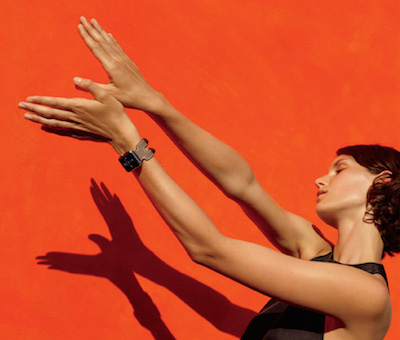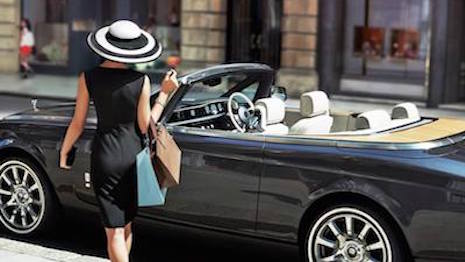NEW YORK – Six in 10 affluent consumers believe that luxury’s definition has changed in the last five years, according to a survey conducted by Ipsos.
Today, 90 percent are inclined to say that luxury holds a different meaning to each individual, while 47 percent note that the quality of luxury goods has declined. Despite these changing attitudes and the addition of new players to the luxury space, history still holds sway when it comes to consumers’ preference for luxury goods, with about 80 percent picking classic over cool.
"We have seen a lot of change in [luxury attitudes] over the past couple of years," said Steve Kraus, chief insights officer at Ipsos, who presented findings of the research firm's November affluent study on Dec. 6. "We do see pretty high levels in terms of most people saying that luxury is in the eye of the beholder.
"Luxury is a little more idiosyncratic and self-defined than it used to be," he said. "Luxury has gotten more personal, a little more intimate, a little more everyday, a little bit more about small indulgences.
"[There is] still a very strong sense of value orientation. I think this is one of the lasting and counterintuitive ways the recession has affected people. In 2006-2007, there was so much aspirational luxury shopping, and you had mass affluents, even upper middle class consumers buying a lot of luxury, and a lot of that was geared towards those classic luxury brands, with those luxury brands responding with lower priced accessories to reach into that marketplace.
"And back in 2006-2007, people said, 'I’m going to buy luxury, it’s going to be expensive, it’s going to be worth it.' Today the expectation is, 'I’m going to buy luxury, and I expect a deal.'"
Luxury in the mix
According to Ipsos’ survey of about 24,000 individuals, more than half of affluent consumers, or 55 percent, purchase luxury at least once a year. Overall, 79 percent have made a luxury purchase at some time.
However, affluents, defined by Ipsos as those with household incomes of at least $100,000, interact with luxury differently than their counterparts who are considered ultra-affluent, with household incomes of $250,000 or more.
Consumers tend to mix the items they buy, trading up in certain categories while buying mass products in others. About two-thirds buy luxury items in at least one category.
However, when looking at ultra-affluents, the number who trade up for at least one type of item rises to 81 percent.

Image courtesy of Bloomingdale's
This reflects consumers growing mindset that more income is needed to afford a luxury lifestyle.
In 2013, the median income of an affluent surveyed by Ipsos was $140,000. These individuals believed that they would need $59,000 in additional income to buy luxury products on a regular basis.
Today, the respondents with a median income of $146,000 report needing $111,000, or a total salary of $257,000 to trade up all the time.
Household income is also a strong indicator of spend. As incomes rise, spending remains largely flat until about $300,000, when there is an uptick in expenditures.
However, while income does predict spending, net worth is a more consistent indicator of a consumer’s purchasing plans.
While the ultra-affluent may have more spending power than the mass affluent, and therefore different purchasing habits, their lifestyles and aspirations are largely the same.
Holiday season sentiment
Judging from this most recent U.S. presidential election, the affluent are not as easily pegged to a particular political mindset today. Since George W. Bush’s win in 2004, Republicans are winning affluents' votes by less points, with those with household incomes higher than $200,000 even shifting support to Democrats in some recent elections.
Consumer sentiment post-election shows that more than half of affluents believe that the country is on the wrong track, compared to only 30 percent who believe the U.S. is on the right path.
Despite this pessimism, average holiday spending is expected to be much the same as recent years, only decreasing slightly from last year. In fact, 65 percent of Ipsos’ respondents said they plan to spend about the same.
Additionally, 58 percent plan to travel during the holidays, up from 56 percent in 2015. Vacations were also mentioned by the most consumers as a luxury or premium item they plan to gift, a reflection of the 67 percent who prefer experiences over things.

Image courtesy of Chopard
Digital channels are going to be important for capturing holiday sales, with about 60 percent of purchases being made on either a desktop computer or mobile device.
Compared to other years, the amount of holiday shoppers who anticipate getting gift inspiration from browsing retailers either online or in-store is trending down, showing shoppers who are less exploratory and more decisive as they go shopping. Similarly, less consumers plan to consult ads or the media.
The amount of people who will turn to their family and friends for cues is stable.
In-store, online and media continue to be the top three channels for reaching well-off consumers.
Luxury today is a more highly researched category than it was a decade ago. Many will look into products online before purchasing in-store, surpassing the number who showroom.

Image courtesy of Saks Fifth Avenue
About two-thirds of affluent audiences crave inspiration rather than information in luxury advertisements, saying that this emotional appeal is more apt to get their attention. This shifts slightly toward information for the ultra-affluent, with 44 percent of those with more ability to buy desiring details.
Overcoming obstacles
A panel discussion following Mr. Kraus’ presentation provided publishing's observations on the industry.
Luxury brands are facing a number of challenges, but the panelists agreed that the ones that are succeeding are those who have stayed true to their story, pricing and positioning. This includes retaining production in their company of origin and refraining from discounting.
Part of surviving also revolves around finding ways to reach the next generation, whether through collaborations such as the Hermès straps for the Apple Watch or lines for fast fashion retailer H&M.

The Apple Watch Hermès
Robb Report's executive vice president and publishing director David Arnold said that while many are worried that millennials will not be the luxury customers that previous generations were, he sees them growing into it once they mature. He pointed to the millionaires who were created via Microsoft's success, who 20 years ago favored Prius cars and charitable contributions over things, but who today are buying the traditional luxury vehicles and mansions.
Preferences come in waves.
James D’Adamo, group advertising director at Hearst Integrated Media, brought up the multigenerational appeal of hospitality disruptor Airbnb, with which Hearst is producing a magazine.
Today Airbnb sees more bookings a night in Paris than the city's hotels. However, rather than only finding an audience in millennials, the platform is also popular among baby boomers.
Luxury also has to contend with consumers' changing lifestyles, as a life of leisure is replaced with one of frenzy, according to Luxury Daily's editor-in-chief Mickey Alam Khan. This shift is visible in the dearth of formal dining rooms today, a feature of the home that lends itself to entertaining and relaxation.
Many brands turn to storytelling to differentiate their products, however authenticity is crucial. A number of brands have been found to be bending truth for their story, such as Shinola's claims its watches were made in the U.S., when they were merely assembled there.
"The danger with some of these brands, particularly with those that are trying to appeal to millennials, is that the narrative is not true," Mr. Arnold said. "And so people get caught out very easily, because I think that social media does play a significant part in the rise of a brand."
{"ct":"O9pPYsP90JRAum1CTe5LrKPBbF9wCVaXIl2\/a5J2Q0derBgQuapaJnHYpF4BFsmQkJFE1U95vijPfFgtOr9vyZfeRxyXEV38SRebe3haZKnC56EbwV81vtav6Af1LjjdvDeWr2ZZ9DgTXf3uEOkShczAJVcwUtR9UJ43wlHrLUMv9gktWZG8XNYxxdMJ7gNATZu6+1Fs+LbRRuijKSoNgMDwXov2jCe+kLMNune0CVH22xCJnOytboNLlGpg0d1Ozo1KqUueNewrYbDFWxI4Xe32JrLdOJVdHw5MwpSdk0gIv2QeD1fOpbLYZ0V+ljojkn175TQLikJKs\/ILmJXqY1yWZCo34j5cXUpUlDtYKp6ftmPa\/kfBF5SewbhPBWnZ8BC9\/JGmuDVvP\/bZP885q3vwVXjMynSyW50S1J\/P+BkhFuLTQMA\/pt\/My4cl\/il\/wxrwvuH9+AbgT2GlyLN6KdrWSN6sMDjolFttlU25NyKrcg038KouKNe9YyZNFiKSftE+V535QAXjwvlEmiQqtL06rs9Uj1FkOVXD+vu+XuW\/IiSOONA9xs2i5cmQ6R+A4umiziP1iEl+D8z5Pk9c8Sl+iLv6mZwstTgbZ75m8lAAAth16iF4\/zzMixrhUrH\/HIKkrEM91VRmnloj3MpBQj\/Tyg0zx3BX8JhxUDFct45ypZvUqePHudO9zZOaf43PESchwgxhi7b9N0utYrpsFEjlU\/GRcHMHZwaeRYTD3NC2RCyJpk6QYK9zUYGa8S+3Dj5TPFTi1DKB67o9AG\/V0OEQjSyuJt7IDdyGnVCyeHN\/KZEevN+QHmvf\/HWyrbb4ChEB6fIVnAL\/rkR+HFuIyskG3tM1+RztNsQmKHEoL1WOv\/wz8rWncFNvE7y1FXoGBh5hZDcZzwCM9kN4dW8KIMsLB7ONjp\/tWmZxUYGfj9L64uP0p\/AHk+tkNeFLx1+PrJ780hOEBMqVmSv\/8l\/pPoRn\/sFCUPyGpEOabkJP3L4inzjaPLZvwNx42ZLuIQYKrQc3T7z9nx9mdNFHR55zRljYvP5vS+rh7qgl143EnN1ax710H4UJpZMEkjOUgNIpB10tOi4SY8gBEstnuAMGZggSvqaPK8qDKXqkyhFDV6JdL7DtcRJS7WjkKRWZhxvcGYhmHOtN3ZGErGzwN25UB+J9upQX1nMswOEcuaR4NLhoBZRF47LFPAPMG1wcpdtpsTPn14ecwCECUdNLhUy0d5cbT58Afp2b5Ox5\/a4TZF15JdgESGXpva92m1ogF00\/ScHU+aI\/84VwBmsO3TlxBdGLgsbqG7+qKq8STUHrqnNdTwxx9ThSpDtwCdnOmf10Nf8AGrVk3FONgZYSLv0MCOZOygMS\/aw3sfTJK+\/0Qhw9Kidaw0+S3g3sqXuD8UtOjA++dT0i5HS9OQ+G866xOZOU5eyAOhomyYtaDELPHi0brnbx0y0c08CRDffXkbTsCRnAQZqfPFihLi6OaIzV4Yxxk1PLMIMdmV6QVAax5fQ0SoDK5j8pWhmQOngdKzwDiGu0vvI3XqouUObBmy+W6on4YwqIQ8rWgRdXst8a0eaZTWCy5QJUSvJzT7BHUBbJfb6cj+W9HaGNs5kL4ZpAJ+IBcaZyvliEieWrb3uZvNnG2Z9nv\/4f+IVy61DhU\/a03MJa5c0y2k8hom27N\/qzhPPoRF0YopMk4VCFs0ZMbb3gvqbyuda1DOQZriUqtwCzc4SIjjr4NVEC1yNwrCsi43gOlgLydxhxA5aKudDiyXeQ0f9o6AqagjXRIs7ZBouxy8gkHz\/4qqKrGaKEzmdSXjinU\/XayhqkNEdBHttuH4U0QOOuhfVdBu6sgPtKaGqmbiIpSc58N6BUOGbUfqVKE+6wi6plX80e1ppUczn3cMa9U8v5g+MEePqDW9OTNiRK6IeONKcmITZ0oCHTdbU\/28XLLhpAFk1f5XJ0dDrIcqzNnfXhLIegeKdUMnypdY0YifL9ChDNJAt2ufbj1fSFvM+G3EG9A6F49hq8sIUvduGJLT9bGaQvz4+rTh+WZ9CSOUALaWic+BfZXXkPdIrcoSph+tRlZDutLHKfWytwaYPWJf1FBMOuNK70LZWr5s2oDXsixrGc02R9zo\/S4Yms5ntuPwMzm3Qk7GhIxt0hv2loXKOjDZNEUmPP99iI0g1OkLr2Cz3F2X1iRFCWomaMjw3AC1V3n7bVxC7RUV7l6gZyYC3Ce\/sIAkLuzroplLYP9jJ6W5FWPfGPbdS+NQ90VD1aF433f7dkc1mdt5wqP8WoxVIRE8VJzy3XCrsyNR36vQHZHvQtpNLH806c7FINM191ExlZbyVsa676NWh8nsvKIuTkgS1laMcM6lEuzM5Rez5KA0rgRAxhsPqRLjcPv85LveNt0GjmBHkX\/eQ7xnNgQtWgYmTAmQgFEWjOWFjyjUDjukqCBB8Nl8en+htxsow7gQ2OoxZpT7hqSBG8d9KynmbUVvBsJRPrzTJeGn5dOz5Jy11jkV0MxF926t3aV0lUjv8y1HLpC\/oduqOJw8fggUcyZ8YcJeHdB76qXprILJv2C7In0UNKwEhOt8LBMj8NpZb38TV5dnYFchNIdgx+n7eiUJKBoa7N7iyU4tsbrUXRRhZpJBG29WnP\/ndBS18qLAbOz+l+ZwEBfURSpdbykHeOvTGOqm\/TJYcJpfqsoHwmfklCooTcRheI8JcBxUXtYobiApNUA1DwKEGo0sAHH83XbraatVAHMaU3DOz8OFqoJ7kuDG3RGKLp4mHPbdgjY3GLk2wL80l0XcTYkjzS9hwpwe9wN\/aScRMmgoEAtVo4EIX\/MAtfMWTqDX52l+68qoqjpdSheu4Q5ym0Qy1jj1fgXijsIoRz0L+siPRgm+uk5hkDg6JondJqrjj0MRx\/JBy254DezShe1NfzTixLOYvIsOmWGfnuzdVA28HztlUGEBSN+15lduz21fIXnSiA2MmsSIs3bI3SNSpyZrWOdN9QYbcD\/qyPfPHDKRO2FKTt+pvOAvRNWLQfmp5C8\/0S4hNEhgS6009Tk6h4RPS0Sl2K350Y1qqZk1rkS2WiL5FTdtxzkVa9LB9pvU\/EGQeaBVW7ABeRdh+6LOgWv5CQcqT9lNBKmRY7hAzeOX7xZKU\/KSRq\/MHgogJ1Q+Ji19UuloPlthUKWNG3BDA2JynzhfvT2\/+3omNbtInZ803F40f4pXzfoOXcJ4TFh4nnT\/1fPpvU8uD02+lyWVn8DxOUpptqwyT1OcjxahrbPH64R\/DqLiANUPvOwkq26eLaoqkkfcbL4Syh\/hlAL7qItxqWowQ1bmPLfTdt0ZJLOQKeOBi1EAlQSyZz7krWvbAXTIoP+NTVeVY\/KRQ42ipl2Oa5e1y\/G+Ee36HcPzDL6JxfnBde+jaa5Xp17KKGB0YGLslESvTSbKlO9vTzdexPdzShQtm5Nsyh6zPuCtOafCJ7Bo761tGZdUmCfVGqgTSEo8e1FRDfgmiJ62ig4HGbqDeEHMJs1aZyMyHccweR6n+HwW6NvNE1TcSaOlkuuI7vd0INByOaZkvHzKfNvrJeeY\/o7o8jNp2F3ecmkPbOESwtb1yKkKQgC8G9YL1Z6Ke7PjQGzjskinX1nr7f1bGj8EPCWyUMgFLUnABokuqYHAWkvqQcewwbHZktRjbRdKfSKMUsW2L7qhea1rdT8GNm2BDq0Nq+IAGjWnhunW9yZb9PjucW2u90Nuo+aBjxLoR5qCGanQa3IvrML3ob70NWnErcTeNeRg+bhhKsowT7oolNrmcJcbOD7vEPqK9KiZd+7itS7wO5W\/8fDpO1mFUVVNKeN4FNAnxMGFvUj1VKP8Im07Apd528Mu7aZ19zn+g9NgMcw45VaF4NxR1n0dIqW5IA+oZUquA1DzaiYOw7LXz33XOGJXpD\/iEfA0dkW5MK6rTgPryfoBimk9lnLk248L8NJCtbtbdx59bb8GCUzNQW3jYC04EuMjWhJG90PUyI\/tpkAHsOFxNwkuGya+eZZ4TRALEjxxuTAndwmkV+H51cljaB2Rr2+YCB9YPwJlblPzIa2EB+TuxxkifQ3uO9t1ilDGhNXPgpOzKXMrNW+LfundFuosfrAdIcREA4MuLoFBDoKd2GJxJTZv2yhyRpvQbFJgqgHOKzwcozKkElVlfiIJNx2fh6JUP1reqmF7luYeHxQwuIOEa8bXSix7gXhFbfjdsljvh2YYUuzjfIwzxjUOhqE+FaIS+n3CwpruRPIPAqVaVzoD6RAd2+c\/2qCYpR\/2UQlwAOv+MNX8OjF16i9\/7o8AdeUVqJv93Be82FvbNuOt9RY58gggb4h2OhM+rSWnpm6OLd2Qej\/rGyj4xNOh0cpRK85jiWWkCk5+5x4Ms8bDpvnHI+R+7vvlBA7oTsVi+ijYUyO+WL4P2xsw4l\/+2x90bM7sjgh+TSM1ahSN38W\/VKxWwD\/t\/060I5WdjmUqnmXXzcAI+K+qbOyVLd8+3QaYDXJcYVxg3n6YbeI1z9uL5eoC6pNZf3fK6+myLMtMDGrbLV0MgqLNh\/iMKew7lcgPzvgxx7jp9N+\/RBERlB+GlqukJq+2zcu7QERhA0up0Uh+fFn2rEWgr4bR9owCSc2rUtTUGWMTmD6jtPlx6wf6zEkNOEuVw\/D0B2WGZo8GuUXGqf37AP8djYflWqVPYUFsGEwH5xTmnWAdcDRVKAreMU08TaIdMJTdP+SCqMXqURuBRRi79Xv2X2\/prtWeNFW20OFRYyYn8keMb4m29+QiBgdBaAMA7+B62\/e\/pMuXZgVVXlQyO831sfjthGzG+n+hKF+W9JaCcD4yg8BHpbEEaHOOtv2ErGqCAZzMlDjqBS\/44o3MU36cZy4ApOE0XCim5O0N\/nB27OaHy9vX2rh3903Fb5WSYOpy5Wtan4OpEeB0rRdNyDIXu+Me0SgF9+AmM2CtRLE+Z2sARSt++qsIDPNenhTHrnNvNDeFR42HaP57+YNAT6VwQxJ+02jZGN8oQzvbMbmEEKxkXG9p3vp5xxi3NhYb6MkvNrUsieXvUes2yIUTTR3SphjSQN9e6rB8ypjIiFLklTswFjlmSXlApFalmQuPwlT6agaQfNPbbUN60ChmARCvVhmBK9kt8pi30uzCKiSa26E6W3i5AhVj1+BY+DSeF6Kt74wcnqQDQNKZJUf5GDgNqKyWSnENGLlibdhnRD8AHk7oIvJYa8AADbjQL0FSWvyAv+R8vDafDyPLyzpLeteq72eOY07Rwfg4ZJSUuhRKZlWx87v2dWxprp5G95fsvW4Q9aHhkLpGH6yDaDzla3NoR0v4ULb\/V\/9r2unkm8ZiLIiUpddmdjY+c6Rc79LhFSNXuCaFCmnbZK35su4CTLBO47Q1RFuHrnlt8Jsj2bfGbxP7hoMZyy0g1mIrZB+8Gwgbkxu+K\/+M0B7Tzd2yKplKPv2Xbvui2GPGuKzetFIA3DloMXhDQUNz7pifA7MFKAgcwKr8jjKXUvg4KqOPEsZzi6Vq3dxgt0v1N59vYz9zdBW4GuMSd5V1DZKtJkZ3HrcsQnxBKBY2WUbFEwgXf3X3wMinKtvwF38UARXFC\/zG6hgDJFJHwCQKp6vJxdr99UTLE\/5J0shNsRrILOR7OIeK85tAtzE7U3fues0my0ByyYuYyWCJq9BsehjUkyXAIAZI7WhDqyA69d6rzPUKJFoT3vyRKjF7KYPBZKHkz8TrZpPXTb2sfo+uaQnx9rDc3oHg8Y09bKYXDbT\/atASiaOiKTG6TEIvoge41S7KDvl0SoFufIKlhfZaSkk8gOy\/7M0Op1\/i\/JoCAGQhoBRWa2vdnR6IQgXcyaGgF+a\/CgdjzG5uq0ckrmc8NhAWN\/g8ItC8L8zPtwg1efsHsf13Y0upOYp07ARStV5kuc1OjdEd6fiYXRRqKBJKuqfSZ2gOZb4chNyGCjTDzfotrIfeaLWoXcShLEfKbi83xwOd4ZN64npxMYVyJmjqdhFrFK4nLFN8GHRgANbHLh69l0Bhf128eV7Sh9vNLoHMF1d\/HIG7o2bBC80VHxz\/YWqGSZgcc7pPUUm1yUj1uP+H+Dft\/2UOPFDECK8QCqdeoEfCgIJUVtsURIcsAHFjy5UeeUnPQISWzZYYa1gyU1GihYQvJ6D+4dPF897\/kjiRWu+ZsXSbmR0Pq39zUGanECouH3pwMzojbHjAo3cdwbbG1yCS5j3XjuY7GwSehd7rr6MgHTWDVV5PsA9uompgRFAjPT4k7AG9L\/457wLpcoV8shmnpfDDh0cuIu3XgJqaY8NiB8\/\/0QJ1INr2NKbOmyA9xpeoP3VcoOhPJgD+abmYrpnIK8RsH6dMd1Mj+0x0OQHm0Dp5qBHmf17rlubPLjCqzT6td0+gjCbknillfvxUUM5c1VN4JMJvSLifqfGIQiFkvVZgJ66IX5cRBL0HmduBPaYcT7pBheCmwzoQzj29nzwW\/rpjFlCTIcVaU0Vs0shAZvnN6QMTHD6dgbUZiY6dQ8qW4+8vZhxlGgz1NATSqw1fFuwLFZyhgBvflGzsWg6Us0A0jAUzI1++NEMtDEVHEq772JLMiksb\/G9i0tZZZR3pRWElCMoyA6PWotVpZ2VdZ8l7IcgzFBdm+DwmRtVXgZtAuJZtjisZogaTyJHoGa\/qpDMtmtCw5iJMTKC2A6WKtwhQPEPGoWgMXKoWlpMkt5wddmnRTaS8wmGl7hqxwm3AK4+pjDYLRLJqBNZPO8\/Cnppl5UCalVzfV6xje\/zHpj14smerBVB95sqqacbJfzDsNG5Cc1qSJGM0rE63Bt0UHAk2s7XaJ9pAgO\/KcPYRh64Cd645ok1Q985OKuzcecYEHRcz0\/W7UqG0h2XYiRbDGXyUxagN\/ntYgffHaz5pIx3q1tbnL4g\/HAx8GjIE0HisTyTg1G15SKVaM3Ej1sOEGvWvCY4auqCSPC05cp7s+JGSPSEg0V0eMnm5DNn0HbdhL06tGTkE28dLGvtobRyZDLaGRluz9YnfzSmrcbcQy2plcCcbSD0I2+COq\/HGBaqZJ8kzo\/vDTLRyDoUkBeEU1yKz7n7zewmhVPQkjRuU8CYbOqvuFlZtM9NRZm7s2miANn0kBI8l9WguCxMbQ03BAmN8W3FyszEZlZ6pUOL4HK9Xq9becyt1AmOwa\/+IuBvH+haTf2TGkxPa+hILCWmfPh6ByRhaYvVPApKIXqGUydYveUmpOQdpc6XHooPER48Qi+hmr5Deqbcz4DWdY3H2htM5ftLW+6X2SyB98cJdbShjYgCGuRJ7KvvOjLxonXvHbA9idCSfqqU3Ui7RnsuMqSLbTH0xqxKtGtn02w0X6MVNwKLrheYjTpXc86kh\/Vw8\/ZEUimrU3GrJqjl6KcBMyn3wRkqaPYIDx\/KS63ExY3u7X4eTRKm\/b+aNy614PwSXJav3mcL3D1MpSRvVgPJ1CeWZsxuvMaKID\/KfWhJ\/Hy1vKsq9YR2vILMioRCHDfvRuSFf1Q6nle\/wxgLfW4V0OsI9V8O5mjMAjuB2shOoX1Wtrwt8J3yvb8lyFyvEURQlTPa2BqN5Dbl2wUaQxXYuKrkXW0BWdGJKbdPMZFao2tSSEJY27SFtJRyFudyEga6U\/9fRKfPM\/1xf8i9aw7NU7wf9DRnLU5tYEEFTeXeSfE0JG6KqhGS6kUwk2N5aa00uPT9As0qKnwxkATdjeWvC4a\/ZmR5qOeebf4jzbyekFKIKFZ5P0Wz6dlnQW2lx33xgvVOAf36Xp2njKgms\/XrtBoFitTqXuR2FbhZn6fZsfCFUQv+V4Ur3e7nF\/dOD3e3XErMJ0tAH28XwiODcIMVnh5fR5cX4fErqTFmH3TiL7te6TapdQAM51hk0I3N4XLzU3zZvr2kjHYpCoChAW2FeRzHwlaC9tPV\/NsN\/AjY4pSZNeyRaMUrSM\/ZHgTBJsYQB+5aBgXLB6qwwoiGOxqG6QSAymHog9p3Ki83FsaOcvDPG2ooBiI\/TiCQBaQx2djFNccX1bnllTgbmGMhsRuB5ib1NkLDJpOa7UH7rmj4TSHZsllVxLwI7xin3ESQiEDsrIdC8cb2KDXUGXdnemDiE0u\/S6ygWxzpxZpxeiLvo4lFAqdQaePy2zWL+f6wnr\/5YxS3M4IzUvv\/xIwAHIwzSDfbxZIXWDLDxVkd0\/GcPExnzhaWmNFKqNiqJkDejge\/NT\/nPE9qtE+93k9SSkYQS765qTbL3PDrbxwv+Hrbvi092zPdE28dP\/9bqEpPEqQgRD5rrImX2Z+Ftp8aWSWYm5B5JNXdhU5V3QNR3DAEsaYaNs91V5pgRm1utY80F1tRew6G2X2b8G5LehRh+60+HaBo7WaFlCdGB6mPir7jOYhin+q14OHh+qHEfcfCEaXCoMginxfFtjOAK+bza0aWGYxw2eIZqYoYKL3932xic4tCqjOxyqkWe82\/kkuUeXlPELuW1EUbDCSVwooBCeOuz+zuvIr4X9Jz\/CDNY05K8DLRQm+lHzZHCHn6B81cvzTMsb4Zo3x0pWQsnGpMNi0\/1Dbf9VW0jEC\/v9pMY2yLGqblr1fS6e3ZPQanWNXLq9aTVEUFEzcYJyJ4vRF9k7j0J+jkLVSu6HApsZvnKHQngXDT2lIrGjHn8DdnbAEB44fFatkh8ERO4nsPDNjfP1PFSD4HsKE7HtTVkSlzhXIeYtscLSx1IlC4\/PBNa0Moozagj42PKwecwFXRkgv01kGZwEmXfM5vPT6r799lZUTQU1Guo+27sG5gzMKiB3kNb4DtC0qrIwHO38mjmCYa3Tnmvio4CFm3z5KyF\/PeK7OOyRekzx7hg5kmh798QkAKZtntK1D0CV5VahdNCMj5RJZ7BAZOJOWCwJdXcrymzbWvRrYF4IeqvWu5FaVdiMWaRf20AyzEHY2vWUu8RX2x02SM5Rod9UsBemKhlCOhvVzOUoI+8LMNO\/QviTmcOsgiRcT+TO0ALRs7vyCfD5ZZikKSFji5v3IhFE7TqSWlf9Sf4YmoAzptPRMGdKkazIHvCvkI0qxniTMtcA2LbvVEGeINA8cANqhst\/ANo\/fe4OPZrNZOZsuA8YlUzY5yCPcYUZH2XPjcvvQdMhZVj+hLvpn7rx73569cQuLwo0uvbR9M7B0PS0493NYG6ehZUfdnMnvNLzJH9eqa7B6PK0p72PhpH13Yk9ed4gf2HBubdE+G4sHfnT7d0QtdJf5aQD0LDKuJ7m4GnEpvhelh7FJcOt+LulD6WV\/KbM1wWBCzIRgLEtMkkqkK9ECZngA2xdSDqXbwtejridsim8MoDbeXl4u0xSwIuvyYtYK1WLzMBj4W3gOHNwOc2\/J13PSzwQL9Ta9Ejoy5TVOO9rB06jHS7lJ4vHu4bpTFFV93QfsTgxfFYSOebhHb+5sv556Gz\/w8chTs2z9sX+o0+UbAMxrW0R+H4XMwOxvjzfXNoVUKb8NPNlXlkr2HCSoHwYH9vRloJ4O7S77h3H0IvDTSwcnF41OevShcFYTseeKBy04zhSY0kfBVaVkbJR6LY0ARwzMTmCx5nJD2lh1udg\/4QS0aFwNGQ8tNkSnPvjRtFlCWNnYxq7ReDFW32m6NEeZf4rcdWrBC7LAXiJ0LwXdTBccJbmDKjCj+9UGPJ1Wl0MuyRE8H22dSSat5aP8tZwdoin5YUYRRRPmrJdVnqTmiQG\/2IA3mvVyoxSWMjwQirBRP14G70fFG020ka+e5j4qxHp0RjextxntmAPlsX5DlZB3BOQKteTUkM17z+EXQmvcj5WCgYO5vg\/r\/IceIQOosykzbShuv1XGYFNIoXN7R9rehlILvnncUpiqiP+TIQrCdqA240\/M3EYmmMT7q4rr9Cw+c9m04eLOuCWhGJTwSrEoVy+HLgi4XV85+nXIuoILhdi4VNPcvWT75DVHxhcG3kAQNJSBRSCxjCVDYiCjQvwIOmwPXseHBk6CpbMJaNCq+tFMiLZl28Msl+E3cTHUOQ7058NMBB5dZ0TEc4pg6WRD8GafOOSaJOji0l+Cf9i4sRN3JQTNErP2wgIEpF59LHcOybbVFexb5IjN\/NL9hOSVylSd6+dQwiWw5+svXZF\/2Tp1CWQCD0r1qXCX1tKG4rwjyjw2Pirblv\/Gg615tvh75XJ2x3WYb1Jhx0mY1gT6pRfdhLBN5Eh8B9mozb\/TUEiKoN6DWjlBKkpuzcMTz+YxtZ+bTci\/JDt5RBNHjS8jA3yGvUv7AB+kixl9Ia8hJTl4P1\/xxKHQceGuz6MHESdHzIezCFFTP3Tvvpqnf7LSsW3rufxdgeTPdDY4mMgMF74SPd3TBr3xtl70pabIfAxjXfrWW+NhFv\/BHHL1cVjCkV6K8H1jAmWvDBe+2ta+cUuojO9VtP2XcPaXM39ju2CB2xye32bVRQbsZelhcqQ94hKcK5y0e0vGFpkrsHDc+bJE2GsSlBmiOM1CYlrdVl73d56JanwJOIMDq+TDKT1JYnxCqVR7HgQ\/Yd6oGGekEqLWmU0xjgwvSXBi0Mya4r1pSzDu+fx4K1e7t0jPSgukEabMPdz\/LO0pin4BPri+FXm482DP+o2NkXkmwAJnduUcW5qfagWm6sM7D65Ds0XN1WHchlQa48dxaBmgxCS4vxjLsyRNIvurR\/fflrLdt6dzEmfNyM3PSRfFvIsqLSJIme1zFphH7JUItyCk7+4E3IPAplu6hQgPuudLaHM4Dt+efr4OEa\/Y8LeCakSbCl2iP\/MyUwGJIGcm\/jFJjKhbeMXeXrH1YYtqjMJ2rgBRgeaotSnkLNXqlRhf0LWeJCOWALDvRP70r8ldPWt+WXS7hH9EoXH5PIZ8FiiwyQMLRMEll221NNB0jD3rgJp23lcUUeX7uyLzMiVo0vxkbmHgICilhw\/BgtsJqwy3+gYuoIGtFdB7QrkqbtFEHzQB\/WOkfIgA9eLaaWEdaRwBUELjyU3CO\/bwCakyTgzQs+\/8WGZZqmlpwbaJVyKAcJeCYjRXDCRwQEYi8CkmhDMqwn2FowNrSd0qLQjzHaafebR\/SADorlIf31ZlytI8ngXIy2eD6X3jOJ6FpwRtMqiNsAmX7GN0sveKxEf2GIpDAhF\/05W1DxHjMny6AiMiWoPOOpmXu5lyVN23Rvh0U1Tqxtftk4DSm\/c5UFBkQej+PsrGKfaoZ\/N74WxMiR169LyGz78akyOfEYKDVHjHMYMh4F665qw6NguTPk4SjDWuXl9MpAPHfdXpvH\/FtZ+ZPs4ZgRcnijCDrnz+g4kl0C3dopHaSqOPT2aNVUbDrezCNRZY9UjFld+\/5mi92xZNySJHXlVz4Vc99KTbwCjqxkojr3DRq7DqXskO869vjEI23llU+ZduDZoFpUfIT80WmGo9smbPwNp7E3Zm5Po4wuoOv6sloJD7iQlk09pWrO5nIgtufaT4se\/SWvpDZRhuMhIH4iftDPqYySax5wM7XiVsENIrMBZmY0cPqdWcVOH2BUcleq8rWP5PvrMDJZvNxBOyzYNzgVb0fnwo48RWfs5urmAuMpMZiUOsa0UyVpTeHoo30Y8UndPLc18rLu7+s8FuSCpCvdhPYknphpheS4vnE9fQs2ZS2BSEFvvVHayIzge+sCN9X11DnvnPYX0NIIFwxtG9co5TH9jq3y7XiOTOw82kH4IFN5pyTJEWL\/xpG6F0aTDhwHhzyb4U\/rYnbckvtAMYHK6lgwZxvnp0lPS2La2OB+2JhmWONJ2fkJ1Wp+HH3jSoc8\/WlOQ0sWCCMYi6qIvZJD8mg4r0AZFoBnyYI0iq3brCLb3BScOUQEqx4oqN8sbh+1Om4tlgEBkGPyFE+aYeKGFf1fNy\/uDC1QdNwp1cFi2QTZJJyV0qoGIC+j09kzfS5nbk9vxvWrQ1VMLTFskKmWsk6L8cy4npwxg668TvvKhwXmwJlS5sD9k+aFTvqzIZk7+NyVuhOfk21l7IiBZEGnISlFfDQ68pfJsQhAZSzXXHPBuiZZLx+4nv31Js5kpkRgjoMactU6LAQ1lW92ohMYyyPjFUWOm7aEDv8Q\/tDa8tQrKWNcq8RTHIUCj\/QHr\/NeOIhZf35PORkR\/oZmDLwBKQqnTkJeYyk9Ih6IyoRthVwWJORBMSUU8ldH2G\/ngwWqW0DB\/UhAFo7tsSYRCReI\/tWzUblBNz1jgo0WoPsHD83ACa4uIv8y4miitGFLwzpSGs\/jJmx5Quo0l6NcHb8cmDDf6gIg2qahYCENiPzNDUdOot5VpkIyeySePTonQ\/GNCwTCWqygwe9VeaVgtQxqBT3x6Z3lJHwQ1syMANINWh09wIhVUyPyXuerYKF7FEoa9ljSvwI6aHYO\/rjSvyrXWhwqSrQD9QTvYgmx7XfFkzRvD7QJwFaH45ClQ\/UQUPplntz51uSHYY8bemor45MzxbAFv4Gqa2eCoEHMhDuVYbZU1VFjj6b6yZIyY1JvycB782Im3ii3q2tRBG55ocjmVuRGWNpsOxY\/Gy5bt3krOryzx1ki7wcVKd6kqjXtlOZnl02nU7PV\/tbmFJxpCVRDns+C2yWTlEPKNMYxWVjNJKeP9XEd4+ykLwSx8ZOL9IL0S+ToAebz0KFNjSaoEMU1vJp11kvuZkPqI0kzWo0x\/+3Uqvh7yV+mGcu\/Jo+2kRsqdE0eHCy+psRWtseCJOsVgGfUa7bjte3dq6PFo7jQ1\/zMDXXXacwOMZeGibLsqXmsSKqTIKHNw0a2Oh8v05AaZLWrLLuL3OBWgMXhpvjokfZIBbcsF2DPXiMHFHl0v6e0pJWytOvZZFLSKLHZKrs7W74iSVFNCyE5Cp4OBEAx86md6m2oCJTHPmS6y1agRMW7iOYQdY80RX95FELfDchRNca0A1hsthrXrDDkoNUnczozVls13hL7kJlFpr4NuYxcPNRCoJhvOR7M1dYMqrcLIxRuMmrymWAtMSONxSts26sp7XpXjw1UsIDz+1fmOKCj\/h5jwpZrE0oQs9yEfjqJopubK9vKhvxc3V4zOar5keVgmrYOH5Rk4zJjrGYj+Qv+h\/2L0DLgT1uT1UjC9DiTYaQG5S3Q8a8c9LWVpP+oOqbBmHWnmyJ6P5cLjLruPCsS56+Kl6B2Q+yx9y96kN\/icyHoMszSqzCV3WHG3uWReiDbl68NmJEFGr0UXWG\/0QK5STIMBk0isRqM1lyTHPaATE\/iajpKSp8Z9RpvLCf1fYWJqPlg3WBAYN5IN1rhzPcyf0FQflTiM5l6lemcxfdx2AgiDukJZ5OnWooBnt1j4Xfqxf+Vut8Ko1p1W3EvbDcIbLWSl9UomJt71IJuStgP9mutIYtP9QAqwGhETebmsDOw8I+8cJHCa\/oBFs1q3eBo+izfT7s6kJcNvFTaFH29UzvxfDXO3iRuuYbcUdl34QWVAKghf9QhpP3ACdMYrmN8qbWAai09xaoIgUQewuakOrJhz32Dphts4XnaQHGvNrh6NSmp12+Z0m8e1llusR+I9cH9nPyUZIsc2sZXA26YYzkMviWhX+BvQBqrdIGurZKqTN9+pL0LHmQCEk5CXYlMzML3cprEPeumuBSPQKcwbSIXLvQd5xTn2L+NSRD1ap5WppzLvGpuN5y1ESqqVIDwMaz8TNV6Llr0Ds\/twIzjmCnhQQcAu4FrHKZes=","iv":"a4a1d5a87f9c61414a5d846f8b7acc6a","s":"e47ead5b4cdeea35"}

 Affluent consumers favor heritage luxury brands
Affluent consumers favor heritage luxury brands